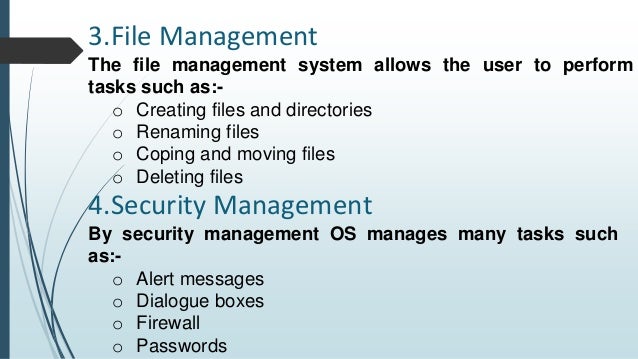Operating System Functions File Management
People working with files have to be able to go to the folder where the system has stored the file. File management programs have a navigation system that.

File A file is a named collection of related information that is recorded on secondary storage such as magnetic disks, magnetic tapes and optical disks. In general, a file is a sequence of bits, bytes, lines or records whose meaning is defined by the files creator and user. File Structure A File Structure should be according to a required format that the operating system can understand. • A file has a certain defined structure according to its type.
• A text file is a sequence of characters organized into lines. • A source file is a sequence of procedures and functions. • An object file is a sequence of bytes organized into blocks that are understandable by the machine. • When operating system defines different file structures, it also contains the code to support these file structure. Unix, MS-DOS support minimum number of file structure. File Type File type refers to the ability of the operating system to distinguish different types of file such as text files source files and binary files etc. Many operating systems support many types of files.
Oconners Windows Games more. Operating system like MS-DOS and UNIX have the following types of files − Ordinary files • These are the files that contain user information. • These may have text, databases or executable program. • The user can apply various operations on such files like add, modify, delete or even remove the entire file. Directory files • These files contain list of file names and other information related to these files.
Special files • These files are also known as device files. • These files represent physical device like disks, terminals, printers, networks, tape drive etc. These files are of two types − • Character special files − data is handled character by character as in case of terminals or printers. • Block special files − data is handled in blocks as in the case of disks and tapes. File Access Mechanisms File access mechanism refers to the manner in which the records of a file may be accessed. There are several ways to access files − • Sequential access • Direct/Random access • Indexed sequential access Sequential access A sequential access is that in which the records are accessed in some sequence, i.e., the information in the file is processed in order, one record after the other. This access method is the most primitive one. Nikon Aw100 Gps File.





